Student journalists document university's story through century-old publications
Story By:
Nathan Wicker '19
The Pine Log writer and sports editor, fall 2017 to spring 2019
Meaghan Morton '19 & '22
The Pine Log editor and editor-in-chief, fall 2017 to spring 2019
Stone Fort yearbook editor-in-chief, fall 2020 to spring 2022
Since SFA's inception, students staffing The Pine Log newspaper and Stone Fort yearbook have documented the university's history. The department of student publications at SFA houses The Pine Log and the Stone Fort — both award-winning, independent, student-run publications. The department has trained hundreds of student journalists who have moved on to successful careers in journalism and photography. The publications have history of their own, covering local and localizing national news while being crucial resources for students in need of campus information.
"Student media give a college a sense of community. It's how readers learn about what's happening now, how they learn about their history, how they celebrate big occasions and how they mourn when there's tragedy," said Chris Whitley, College Media Association president. "College media bind all the parts of the college together. That's why college media need to be supported and why they should be celebrated when they reach milestone anniversaries."
To honor the 100 years of history the newspaper and yearbook have both shared with their university, we retold some of the major moments that shaped the trajectory of both publications over the past century.
- 1924-29 / The Beginning
- 1930-39 / The Great Depression
- 1940-49 / "TOTAL WAR"
- 1950-59 / Community Loss
- 1960-69 / Family Matters
- 1970-79 / 'Can Ya Dig It?' Student Publications has the Scoop
- 1980-89 / A Tubular Time for Student Journalism
- 1990-99 / A New Look
- 2000-09 / If It Bleeds, It Leads
- 2010-19 / Logos Tell Stories
- 2020-Present / The End of Print
1924-29 / THE BEGINNING
Among a number of changes taking place in East Texas in 1924 was the addition of SFA's Stone Fort yearbook and The Pine Log newspaper. For its first issue printed May 31, 1924, The Pine Log staff consisted of two: Editor-in-Chief Mary Edwards of Troup — whose father was the editor of The Troup Banner and The Tyler Journal — and Business Manager Greer Orton Jr. of Nacogdoches. The two, under the supervision of faculty member Dr. Thomas E. Ferguson, disseminated the news of the graduating class and encouraged students to pick up the inaugural Stone Fort yearbook.
In the newspaper's first editorial, Edwards set the intent for every future Pine Log: "Its purpose, as is indicated by the name, is to be an organ of expression for the College community — the Stephen F. Austin State Teachers College community. Its purpose is to give the news pertaining to this particular community."
Luther J. Garner, editor, and Grady Thompson, manager, captured the brief history of the school in the yearbook with portraits, illustrations, text detailing events and organizations, and a dedication to the first president, Dr. A.W. Birdwell. In the first issue of The Pine Log, staffers wrote about the first book and a letter the engravers (now referred to as printers) sent to the staff. It read, "We have just received a copy of the 1924 Stone Fort, and wish to commend you, your staff, and your student body on the excellent annual that you have edited for your first year. It is quite out of the ordinary and far beyond the books put out by the average young college."
1930-39 / THE GREAT DEPRESSION
Student publications have always been a safe space for journalists to learn and practice their craft. In the Sept. 18, 1939, issue of The Pine Log, an advertisement calls on interested students to join the staff: "No experience is required — only a willingness to work."
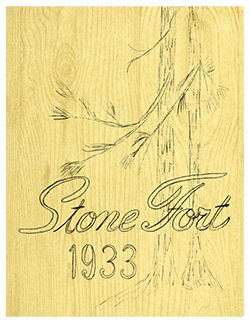
However, a willingness to work couldn't save the Stone Fort yearbook from the effects of the Great Depression. Lack of funds made printing a full-scale yearbook out of the question. In its place, Madge Stallings, former director of the SFA printing operation, collected information from friends and families of the 1933 senior class to create a 28-page publication for the class's 1958 Homecoming. The pages were dotted with illustrated doodles and gave information about the students 25 years prior and their then-current professions. Among the class were "housewives," teachers and Louise Spies, a former Stone Fort editor and Pine logger who was co-owner of Patterson Publishing Company.
1940-49 / "TOTAL WAR"
No doubt following the lead of their professional counterparts engaging in the era's yellow journalism practices, Pine Log staffers weren't reporting only hard news in the paper's columns. A section recurring since the 1920s, "The Campus Rambler," dished out nondescript gossip. An entry from the June 30, 1947, edition read, "It certainly must be love when a girl gets up at 7:00 on Sunday morning and catches a bus."
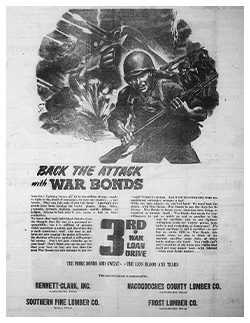
As idle gossip spread, the students also began to endure the effects of World War II. "Students Prepare to Face Total War; Dr. Birdwell Tells Students What They Can Do in National Emergency" was emblazoned across the top of the first page of the Dec. 13, 1941, edition of The Pine Log. Birdwell gave three points of advice for students as they prepared, not knowing they would face four more years of war:
- Be calm and keep poised. Do not believe everything you hear until you know it is from an official source. Do not discuss unconfirmed war rumors.
- Continue with recreational entertainments and schoolwork as in normal times. This will relieve tension and make life more enjoyable in these critical times. Also, you should accept any opportunity to help in any kind of patriotic work. Use your talents for rallies, bond drives and to assist the Red Cross.
- Prepare for a 10-year struggle with the Axis. Furthermore, students should not enter the Army with the idea that your future is blasted. There have been several instances where young men have found exactly what they wanted to do while serving in the Armed Forces of America.
1950-59 / COMMUNITY LOSS
Not only was The Pine Log a way for students to get the latest on clubs and organizations, but it was also a way to build community, keep up with peers and publish opinions that would influence campus politics. Pine loggers reported on events like the ballot box stuffing that took place during the student body president race in April 1953.
"Local or student papers report on the issues that affect the community and also help you better understand the community you live in," said Chris Cotton '21, SFA's current university archives and research coordinator. "Yearbooks are much the same except it is an entire year's worth of important events condensed into a few hundred pages. The Stone Fort often has features written by students that tell me pieces of SFA history that I only knew a little about, but those pieces can really fill in the gaps."
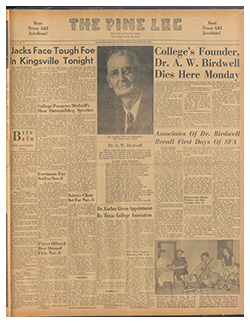
On Oct. 25, 1954, SFA took one of its biggest blows with the death of its first president, Dr. Alton W. Birdwell. Five days later, papers hit the stands making the community aware of his death. Included in the issue were a previously run poem about Birdwell by a student, memories from associates of Birdwell recalling the first days of SFA, and an article honoring his most outstanding speeches. He was president emeritus at the time of his death. Four years later, SFA's second president Dr. Paul L. Boynton died in his office on campus. Dr. Ralph W. Steen was then chosen as the college's third president.
1960-69 / FAMILY MATTERS

Bettye (Herrington) Craddock '70 & '72, found her heart in student publications and would later dedicate her days writing her master's thesis, "The Golden Years: The First Half Century of Stephen F. Austin State University," detailing the university's history.
She and her then-future husband, Van Craddock '70, both worked for the publications and met in the class of Ben Hobbs, communications professor and student publications supporter. Bettye held many positions within student publications, and Van was the sports editor for The Pine Log. It was in Hobbs' class that Van leaned on a chalkboard rail and asked Bettye on a date. After the two Pine loggers were married, Hobbs gifted the chalkboard rail to the Craddocks. Bettye still has the rail in her home as a fond memory and reminder of her late husband, who died in 2022.
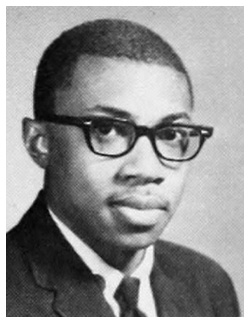
SFA enrolled its first Black student in 1964. However, it wasn't until the late '60s that The Pine Log had its first Black editor, Wilbert Love Jr. '69 of Grapeland. In 1969, Bettye traveled with Love and other editors to San Antonio to attend the Texas Intercollegiate Press Association convention — the oldest state collegiate press association in the nation.
The group searched for a place to eat along the riverwalk. As they began to walk into a restaurant, the group was stopped.
"We were stopped at the door and the waiter said, 'You all can come in,' but he pointed at Wilbert and said, 'He cannot. No Blacks allowed.' We said, 'No, thank you,' walked out of that place and found somewhere else. We were insulted. He was our friend," Bettye said.
Bettye found herself having to say goodbye to Van in 1969 when he was conscripted into the Vietnam War through a lottery-style draft.
"Van said it was the only lottery he ever won," Bettye said. "Winning that is ensuring you a one-way ticket to Vietnam. We were listening to the radio waiting to hear the numbers. July 1 was number 93, and that assured he would be sent to Vietnam. We went into the dorm where I lived, and everybody was just sitting gathered around this one TV in the corner. It was either people cheering or people crying. Vietnam was breathing down a lot of people's necks."
1970-79 / 'CAN YA DIG IT?' STUDENT PUBLICATIONS HAS THE SCOOP
Facing the end of the Vietnam War, national integration issues and an increasingly diverse student body, student journalists at SFA had ample opportunities to practice their craft.
Wanda (Peterson) Mouton '74, a spry reporter for The Pine Log at the beginning of the decade, recalled those times fondly. "The 1970s were an exciting time on campus, and we on the newspaper did not lack for stories to cover on a weekly basis," she said.
As Mouton recalls, one of the biggest series of stories at the time was the streaking incidents of 1973-74, which concluded with the Streak Party Night at SFA that was approved by then-President Steen. Stories were published about students streaking in classes, the student center, on the football field and anywhere student groups gathered regularly.

Local stories of the decade ranged from alcohol consumption at campus organization functions, anti-war protests, bra-burnings and former SFA mascot Keith Wyborny '74 — a male who ran and lost the race for Homecoming queen in 1973. The decade was also The Pine Log's introduction to running editorials on national issues, such as the Vietnam War, racial tensions and the Watergate scandal, to name a few.
1980-89 / A TUBULAR TIME FOR STUDENT JOURNALISM
Student journalists learn to adapt to reporting on a smorgasbord of stories as they happen. In the 1980s, for example, stories involving Greek life and successes in softball and football filled SFA newspapers and yearbooks.
Rhonda Minton '90 & '99, Pine Log editor in 1989, covered then-President Dr. William R. Johnson's unexpected retirement in October 1989. On the day of the announcement, after seeing Johnson enter the crowded auditorium through an inconspicuous side door, Minton had a journalistic hunch he'd make a swift exit the same way.
After the announcement, Minton quickly walked to the side door where Johnson greeted her with a smile.
"I asked if I could walk back with him toward the Austin Building," Minton recalled. "We talked, and I asked if it was possible to meet again later in the day for a story on him for The Pine Log."
Minton was the only reporter to get an exclusive interview that day.
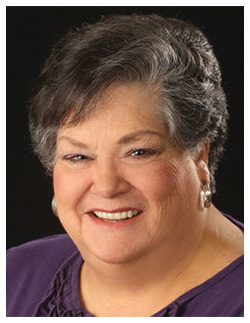
In 1986, student publications also gained a new leader, Pat Spence, who is revered by many past students as the matriarch of SFA's student publications department. Spence led the publications to tremendous heights for 28 years.
"My initial hope and goals were that we could bring the paper up to a level where it could compete statewide with other college newspapers, and I believe we achieved that and even surpassed that goal in some cases," Spence said.
"My fondest memories are with all my kids. All of the honors and awards don't mean anything without those kids and their successes. That's what we were there for — to get them to a place in their lives where they could be happy and make a living."
Pat Spence
1990-99 / A NEW LOOK
In 1991, a desire to breathe fresh life into the Stone Fort yearbook's design topped the staff's priorities.
Backed by Spence, Robert Seale '92, chief photographer from 1988 to 1992 and co-editor of the 1991 yearbook, and his staff wanted to take a fresh and sophisticated approach to an otherwise outdated design.
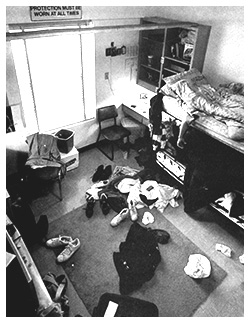
"We wanted to include things that everyone experienced," Seale said.
By cutting out mundane photo captions that were prevalent in past issues, opting for a slick black cover with a small SFA silhouette and styling it similar to a coffee table book, the 1991 yearbook paved a path for future editions.
For Rachel Stallard '95 & '99, newspaper executive editor at the time, the Oklahoma City bombing on April 19, 1995, stood out as one of the decade's most notable events.
Stallard recalled contacting alumni living in Oklahoma City at the time of the bombing.
"A few people answered the phones and told me they had felt the blast," Stallard said. "I did not find any of our students who had been in the building at the time."
"Working at a newspaper was like a passport to do all the interesting things you wanted to do."
Robert Seale '92
2000-09 / IF IT BLEEDS, IT LEADS
The turn of the millennium brought with it a change to the scale of news on which staffers were reporting.
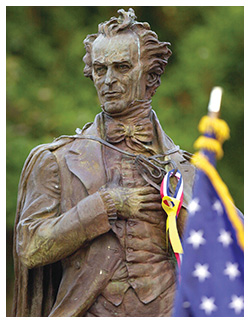
The Pine Log reported on many notable events throughout the decade. However, it was the tragic events of Sept. 11, 2001, and the Space Shuttle Columbia disaster Feb. 1, 2003, that dominated the decade's headlines.
"It was a numb, surreal time," recalled Chris Anderson '03 and Kathryn Morton '02 & '04, editor and feature editor, respectively, during 9/11.
As the campus community was catapulted into a state of sorrow and fear, Pine Log staff members reacted. The publication enlisted the help of Clare Williams '09, a Pine Log alumna who was interning in New York City during the attacks, to provide eye-witness accounts.
In the Sept. 13, 2001, issue of The Pine Log, Williams' haunting accounts were printed on the front page, and many staffers and students wrote about the events from a local perspective, including commentary from Anderson.
"1,520 miles. The daunting distance separating Nacogdoches and New York City seems to have just gotten closer," Anderson wrote. Less than two years later, the Space Shuttle Columbia disaster hit a little closer to home.
Anderson, who was in Denton when news broke of the disaster, dashed back to Nacogdoches. With the help of Sam Craft '04, former photo editor, and Jamie (Fussell) Bouldin '05, former editorial editor, they immediately gathered staff members to begin coverage.
"I knew instantly this was a massive story and a life-changing event for us Pine loggers," Anderson said. "At that point, our paper was known for pushing news, and we really prided ourselves on doing everything as best as we could to tell stories that related to SFA. I'm forever proud of that."
While some staffers covered the events, others led NASA officials around Nacogdoches County to find shuttle parts. Staffers worked alongside national and international reporters from prominent publications, who also used the student publications' office for internet.
"Every university needs a watchdog. And that's what student publications are."
Chris Anderson '03
2010-19 / LOGOS TELL STORIES
The decade brought with it a lot of excitement for student publications. SFA was hurled into the national spotlight as a basketball powerhouse, the university turned 90 years old, and campus was revitalized with new structures, such as Lumberjack Landing and the Cole STEM Building.
One event, however, stands out to Kasi (Dickerson) Key '13 & '15 as excitement for perhaps the wrong reasons. Key served as editor-in-chief from 2013 to 2014 and remembers outrage over a proposed change to the university logo, sparked from a leaked photo on Twitter the day before the big reveal.
"It was an all-hands-on-deck situation as we worked to cover all the different angles of the story," Key said.
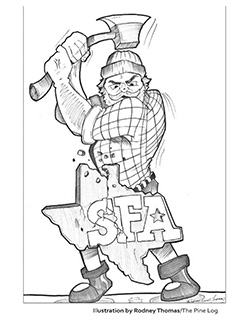
The Pine Log staff members covered every step of the logo saga, from reporting on meetings and online petitions to interviewing SFA administrators and representatives from Richards/Carlberg, now Carlberg Branding & Advertising — the firm responsible for the proposed logo and rebranding campaign. The saga was covered until then-President Dr. Baker Pattillo axed the new logo in late March 2014.
On Dec. 30, 2018, tragedy struck the university as Pattillo, SFA's eighth president who was appointed in 2006, passed away after nearly 13 years as the university's top administrator. The Pine Log ran a full-page tribute in the Jan. 30, 2019, edition.
2020-PRESENT / THE END OF PRINT
The Pine Log, along with media outlets around the world, could not evade the devastating blow that the COVID-19 pandemic had on print media.
Following media trends, a decline in print advertising revenue and changes in how society consumed news, The Pine Log ended print editions and went fully online in March 2020. Originally slated to go fully online in summer 2020, the university shutdown pushed the transition forward several months.
"I think we were all a little heartbroken," said Meredith Janning '21 & '23, former Pine Log editor-in-chief. "There technically wouldn't be any more worknights, no more page review sessions. I'm sure there was maybe a little bit of fear, too, because with such a big change, nobody could say what the next semester would look like."
But students again rose to the challenge, taking advantage of opportunities to break news any day of the week rather than being tied down to print deadlines. The newspaper continues to win state awards each year for its online content.
The Stone Fort yearbook, however, remains a printed publication and continues to be a shining example of excellence in print media.
In September 2022, the yearbook earned national recognition as a finalist in two categories of the prestigious College Media Association Pinnacle Awards. As of spring 2022, only eight universities in Texas were producing traditional, printed yearbooks.
As the university's story is well-documented through the worn, yellowed editions of The Pine Log newspaper and Stone Fort yearbook, so, too, are the memories — good and bad — of the gutsy staff members who sought to tell those stories. Though not all memories may be documented in print or online, they endure between the special bonds forged from late production nights, sudden news breaks and early morning ice cream excursions. For the next 100 years as they have in the last, may SFA's student publications live on as an unwavering service documenting the university's history and success.

 Axe ’Em, Jacks!
Axe ’Em, Jacks!